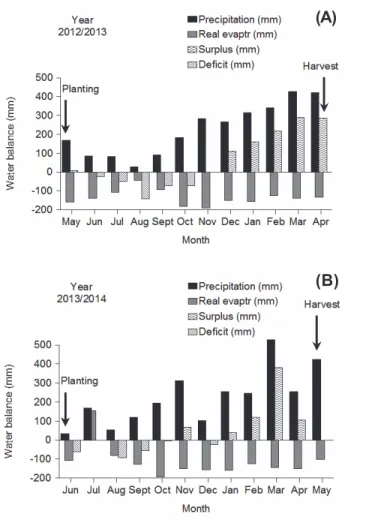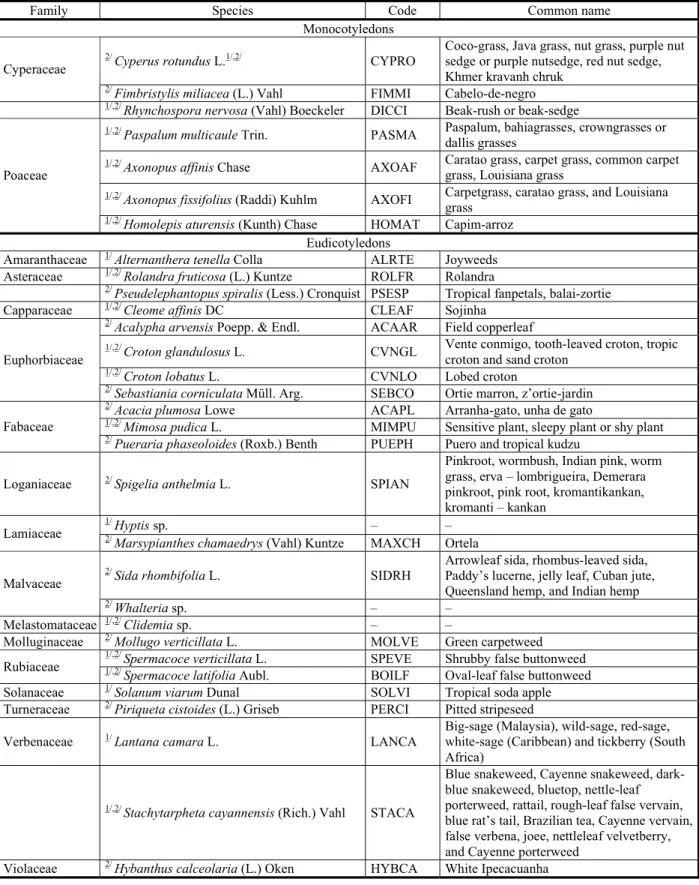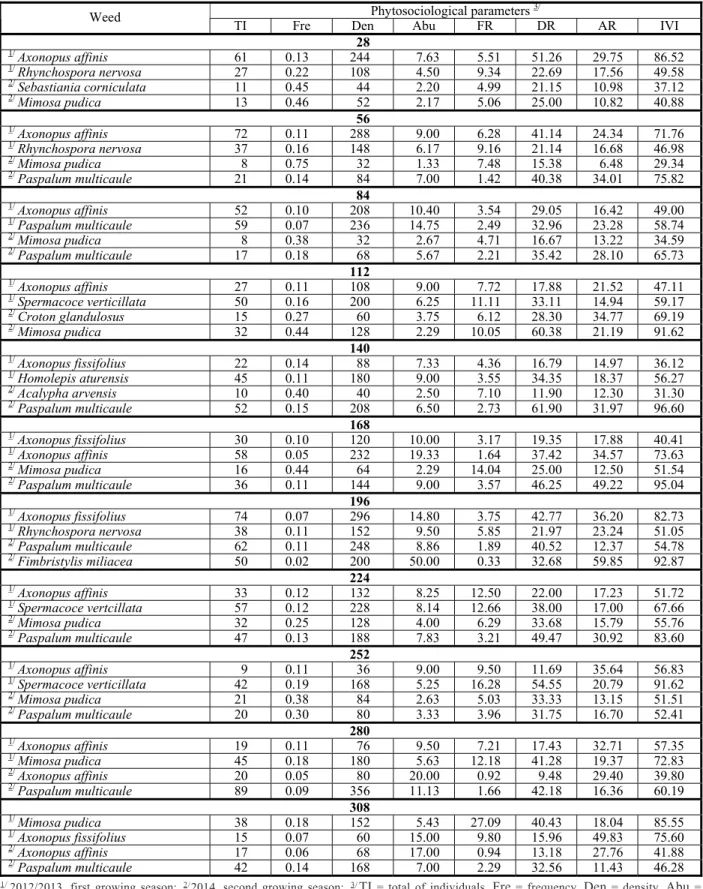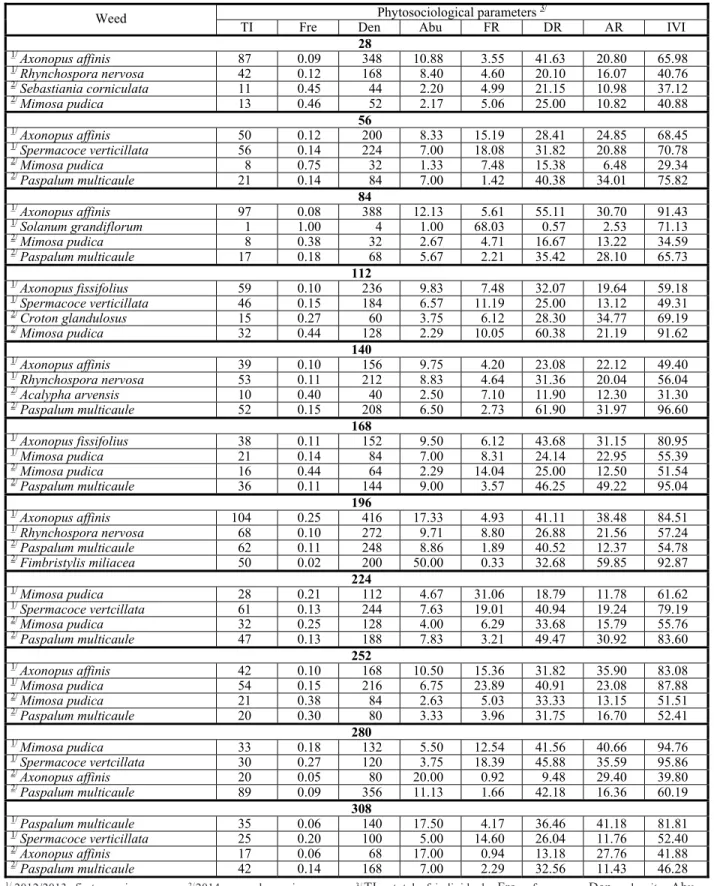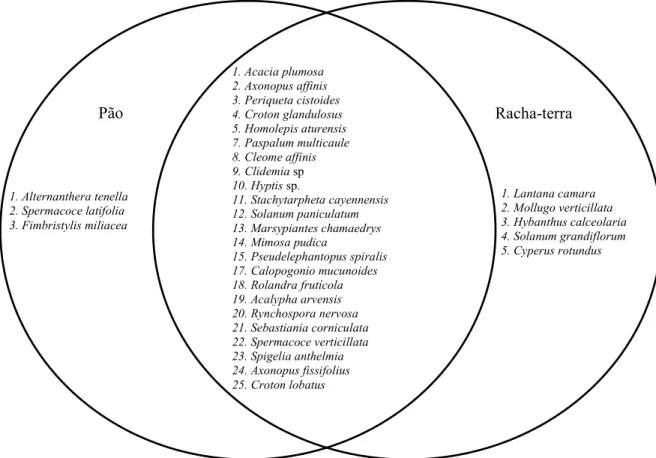267
Phytosociology of weeds in cultivation of two varieties of cassava1 Recebido para publicação em 8.7.2015 e aprovado em 22.1.2016.
2 Universidade Federal do Amazonas (UFAM), Benjamin Constant-AM, Brasil, <libiamileo@ufam.edu.br>; 3 Universidade Federal do Amazonas (UFAM), Manaus-AM, Brasil.
P
HYTOSOCIOLOGY OFW
EEDS INC
ULTIVATION OFT
WOV
ARIETIES OFC
ASSAVA1Fitossociologia de Plantas Daninhas em Cultivo de Duas Variedades de Mandioca
MILÉO, L.J.2, SILVA, J.F.3, ALBERTINO, S.M.F.3, LEITE, B.N.3, MENEZES, D.S.3, and
SANTOS, A.F.3
ABSTRACT - This study has aimed to carry out a phytosociological survey of weeds in different collection periods, in cassava crops of two varieties grown in two consecutive years. The varieties were Pão, of the sweet class, and Racha-terra, of the bitter class. The weeds surveys were performed at 28, 56, 84, 112, 140, 168, 196, 224, 252, 280 and 308 days after planting in the experimental units of each variety. For weeds sampling, a sampler with an area of 0.25 m2 released twice at random in the floor area of the treatments was used. The phytosociological survey quantified 5,708 individuals distributed in 17 families, represented by 32 species, of which 25 were dicotyledonous and seven were monocotyledonous. The most representative families in number of species were Euphorbiaceae and Poaceae, followed by Cyperaceae and Fabaceae. The most important species in the two growing seasons were
Axonopus affinis, Mimosa pudica, Spermacoce verticillata and Paspalum multicaule. Other important
species of the Poaceae family were Axonopus affinis, Axonopus fissifolius and Homolepis aturensis.
Keywords: competition, tillage, Manihot esculenta.
RESUMO - Este estudo objetivou realizar levantamento fitossociológico de plantas daninhas em diferentes períodos de coleta, em cultivo de duas variedades de mandioca, em dois anos consecutivos. As variedades foram Pão, da classe mansa, e Racha-terra, da classe brava. Os levantamentos das plantas daninhas foram realizados aos 28, 56, 84, 112, 140, 168, 196, 224, 252, 280 e 308 dias após o plantio, nas unidades experimentais de cada variedade. Na amostragem das plantas daninhas foi usado um quadro com área de 0,25 m2, lançado por duas vezes, ao acaso, na área útil dos tratamentos. O levantamento fitossociológico nos dois anos agrícolas quantificou 5.708 indivíduos, distribuídos em 17 famílias, representadas por 32 espécies, das quais 25 eram eudicotiledôneas e sete eram monocotiledôneas. As famílias mais representativas em número de espécies foram Euphorbiaceae e Poaceae, seguidas de Cyperaceae e Fabaceae. As espécies de maior importância nos dois anos agrícolas foram Axonopus affinis, Mimosa pudica, Spermacoce verticillata e Paspalum multicaule. Outras espécies importantes da família Poaceae foram Axonopus affinis, Axonopus fissifolius, Homolepis aturensis.
Palavras-chave: competição, lavoura, Manihot esculenta.
INTRODUCTION
Cassava is a boosting food much consumed in tropical regions of the world. In Brazil, cassava root is among the most harvested products, surpassed only by soybeans, wheat, rice and maize, and the average yield is 13.9 t ha-1 (IBGE, 2014).
In the Brazilian state of Amazonas, the occurrence of cassava crops in all
municipalities, coupled with the diversity of varieties, shows the evidence of agricultural, economic and social importance of the root in the state, where the average productivity is 11.7 t ha-1 (IBGE, 2014).
growth, prioritizing the environmental resources. Therefore, they typically have an advantage when using these ones (Gustafson et al., 2004).
Weed management is a key component in agricultural production, especially for small farmers. However, many of these farmers have neglected the proper management, believing that it is not necessary to control weeds because of the cassava hardiness (Albuquerque et al., 2008).
To understand the dynamics of weeds living in cultures in different stages of growth, it is necessary to identify them because not all species are equally important in the interference imposed on the crop. Each species has the potential to settle in the area and their aggression can act differently among cultivated plants (Cruz et al., 2009).
Phytosociological studies evaluate the weeds population by means of indices that identify the most significant species of an infesting community for which management practices or changes in the system should be determined in order to facilitate their control (Marques et al., 2011). Weeds interference on cassava varieties may be related to the peculiarities of each region, especially of the predominant species (Johanns & Contiero, 2006).
Considering the importance of cassava roots as food for the population and economic activity for the Amazonian farmers, coupled with the lack of research on local varieties and weeds identification, this work aimed to carry out a phytosociological survey of weeds in different harvesting periods, in cultivation of two varieties of cassava and in two consecutive experiments.
MATERIALS AND METHODS
The weeds survey was carried out in cassava crops in two competition experiments conducted during growing seasons 2012/2013 and 2013/2014. The site climate is tropical humid, corresponding to the Afi type in the Köppen classification, with relative humidity between 75 and 80% and annual rainfall from 1,750 to 2,500 mm (Mota & Medeiros, 2002). The water balance data of the periods during
the weeds surveys (Figures 1A and B) were obtained at the Instituto Nacional de Meteorologia (Weather District of the National Meteorology Institute) (INMET)). Soil preparation consisted of vegetation mowing followed by harrowing. The analysis of the chemical characteristics was of a soil composite sample removed prior to settling each experiment.
Planting fertilization was based on the results of the analyses and recommendation for cassava cultivation in the Brazilian state of Amazonas, according to Dias et al. (2004). Each experiment was conducted for a period of 11 months, and the first one was from May/2012 to April/2013 and the second one was from June/2013 to May/2014. The
Figure 1 - Water balance for the Brazilian municipality of Manaus in the period from May/2012 to April/2013 (A) and from June/2013 to May/2014 (B). INMET (Instituto National de Meteorologia; National Institute of Meteorology) network data, 2014.
(A)
spreading material was from the Brazilian city of Benjamin Constant, AM. The cuttings were taken from the 10-month-old plants middle third of varieties Pão (sweet) and Racha-terra (bitter). The criteria for selection of varieties were difference in hydrogen cyanide content, erectness, purpose of cultivation, the farmer’s preference and the local consumer’s acceptance.
The weeds collection was done in an interference experiment settled in a randomized block design and a 2 x 2 x 12 factorial arrangement, being two varieties of cassava (Pão and Racha-terra), two weed managements (control and coexistence with the cassava crop) and 12 evaluation periods (0, 28, 56, 84, 112, 140, 168, 196, 224, 252, 280 and 308 days after planting) with four replications. Before settling the experiment, to provide the same conditions to all treatments, paraquat was applied in a dose of 0.6 kg ha-1.
The experimental units of each variety were composed of four lines of planting, with a spacing of 1.0 m between rows and 0.80 m between plants. The floor area for assessment
consisted of two central rows, except for the plants in the end of each row, totaling eight plants of each variety.
The weeds were collected at different stages of the varieties development cycle, corresponding to the periods of coexistence with cassava. These periods were at every interval of 28 days after planting (DAP) up to 308 DAP.
Weeds sampling was by using a 0.25-m2 frame thrown twice at random on the floor area of each experimental unit. The plants contained within the frame were collected, placed in plastic bags and taken to the laboratory for identification and quantification of the species.
The weeds were identified by class, family, genus, species, code (Kissmann & Groth, 1997) and with the help of the specialized literature and exsiccated specimens prepared from samples collected with flower and/or fruit for comparison with official herbarium specimens.
The phytosociological analysis was obtained by parameters calculated according to Mueller-Dombois & Ellenberg (1974), described below: used plots of number total species the contain that plots of number (Fre)
Frequency =
area total species per s individual of number total (Den) Density =
species the contain that plots of number total species per s individual of number total (Abu) Abundance = 100 species all of frequency total species the of frequency (Frer) frequency
Relative = ×
100 species all of density total species the of density (Denr) density
Relative = ×
100 species all of abundance total species the of abundance (Abur) abundance
Relative = ×
RESULTS AND DISCUSSION
The weeds survey in the first year (2012/ 2013) showed 3,531 individuals distributed in 18 species from the eudicotyledonous (13) and monocotyledonous (5) classes. In the second year (2013/2014) 2177 individual were obtained, distributed in 28 species, being 21 eudicotyledonous and seven monocotyledonous (Table 1). Despite the difference regarding the number of species between the two surveys, stood out
Rhynchospora nervosa, Paspalum multicaule, Axonopus affinis, Axonopus fissifolius, Homolepis aturensis, Rolandra fruticosa, Cleome affinis, Croton glandulosus, Croton lobatus, Mimosa pudica, Clidemia sp., Spermacoce verticillata, Spermacoce latifolia and
Stachytarpheta cayennensis occurring in the two years of the survey (Table 1). The presence of these weeds even when the rainfall was lower (Figure 1B) can be attributed to the strategies that these species have developed to remain in adverse conditions (Maluta et al., 2011).
In the two consecutive years, the dominance of unique and common eudicotyledonous species accounted for 73.9% of the total weeds collected and identified, belonging to 15 families (Table 1). In an experiment with maize cultivation, it was recorded that 60% of the weeds were eudicotyledonous (Albuquerque et al., 2012). The largest number of individuals (3,531) found in the first growing season may be associated with the amount of rainfall that occurred in that period, probably favoring the germination and establishment of weeds (Figure 1A). Otherwise, the lowest precipitation (Figure 1B) was insufficient to develop species to emerge and may have reduced the number of individuals (2,177) in the second year.
The results are consistent with those in the study by Roberts (1984), who found a relationship in the weeds emergence flow with rainfall when this one occurred during or after the wet period or had reduced or delayed emergence in dry periods. This author further states that most seeds delayed germination due to low soil moisture, while others remained dormant until the occurrence of new rains. However, there was no delay in emergence when the soil was at field capacity.
Regarding the number of families, the most representative in species found in the two surveys were Euphorbiaceae and Poaceae (four), followed by Cyperaceae and Fabaceae (three) and Asteraceae, Lamiaceae, Malvaceae, Rubiaceae and Verbenaceae (twp). The remaining families had only one species each (Table 1). Cardoso et al. (2013), in a phytosociology study of a cassava crop in the Brazilian state of Bahia, have also found a greater number of Poaceae species. The occurrence of this family with a large number of species has also been recorded in the Amazon region. Besides this family, Fabaceae is among the most frequent ones in this crop.
Regarding the species Cyperus rotundus,
Alternanthera tenella, Cleome affinis, Croton lobatus and Mollugo verticillata,found in this study, they are mentioned by Lorenzi (2013) as infesting agro-ecosystems. These species show rapid germination, a short development cycle and a high production of diaspores and resources partition in reproductive structures, and can be aggressive in competition in crops (Soares et al., 2003).
The phytosociological parameters of weeds with higher importance value indices (IVI) identified in the treatments with the variety Pão during growing seasons 2012/2013 and 2013/2014 are shown in Table 2.
In general, frequency (Fre) and abundance (Abu) show low values, while density (Den) showed high values. This last parameter and the number of species are indicators of adaptation and competitive ability that weeds can have on the cultivation and some are more suited to environments where cassava commonly develops (Durigan, 1988).
With regard to the phytosociology parameters in the first growing season,
Table 1 - Weeds collected in cassava cultivation during two growing seasons (2012/2013 and 2013/2014) identified by class, family, species, code and common name. Manaus, AM
2012/2013, first growing season; 2013/2014, second growing season.
1/ 2/
Family Species Code Common name
Monocotyledons
2/
Cyperus rotundus L.1/,2/ CYPRO
Coco-grass, Java grass, nut grass, purple nut sedge or purple nutsedge, red nut sedge, Khmer kravanh chruk
Cyperaceae
2/
Fimbristylis miliacea (L.) Vahl FIMMI Cabelo-de-negro
1/,2/
Rhynchospora nervosa (Vahl) Boeckeler DICCI Beak-rush or beak-sedge
1/,2/
Paspalum multicaule Trin. PASMA Paspalum, bahiagrasses, crowngrasses or dallis grasses
1/,2/
Axonopus affinis Chase AXOAF Caratao grass, carpet grass, common carpet grass, Louisiana grass
1/,2/ Axonopus fissifolius (Raddi) Kuhlm AXOFI Carpetgrass, caratao grass, and Louisiana
grass Poaceae
1/,2/
Homolepis aturensis (Kunth) Chase HOMAT Capim-arroz Eudicotyledons
Amaranthaceae 1/ Alternanthera tenella Colla ALRTE Joyweeds
Asteraceae 1/,2/ Rolandra fruticosa (L.) Kuntze ROLFR Rolandra
2/
Pseudelephantopus spiralis (Less.) Cronquist PSESP Tropical fanpetals, balai-zortie
Capparaceae 1/,2/ Cleome affinis DC CLEAF Sojinha
2/
Acalypha arvensis Poepp. & Endl. ACAAR Field copperleaf
1/,2/
Croton glandulosus L. CVNGL Vente conmigo, tooth-leaved croton, tropic croton and sand croton
1/,2/
Croton lobatus L. CVNLO Lobed croton
Euphorbiaceae
2/
Sebastiania corniculata Müll. Arg. SEBCO Ortie marron, z’ortie-jardin
2/
Acacia plumosa Lowe ACAPL Arranha-gato, unha de gato
1/,2/
Mimosa pudica L. MIMPU Sensitive plant, sleepy plant or shy plant Fabaceae
2/
Pueraria phaseoloides (Roxb.) Benth PUEPH Puero and tropical kudzu
Loganiaceae 2/ Spigelia anthelmia L. SPIAN
Pinkroot, wormbush, Indian pink, worm grass, erva – lombrigueira, Demerara pinkroot, pink root, kromantikankan, kromanti – kankan
1/
Hyptis sp. – –
Lamiaceae 2/
Marsypianthes chamaedrys (Vahl) Kuntze MAXCH Ortela
2/
Sida rhombifolia L. SIDRH
Arrowleaf sida, rhombus-leaved sida, Paddy’s lucerne, jelly leaf, Cuban jute, Queensland hemp, and Indian hemp Malvaceae
2/
Whalteria sp. – –
Melastomataceae 1/,2/ Clidemia sp. – –
Molluginaceae 2/ Mollugo verticillata L. MOLVE Green carpetweed
1/,2/
Spermacoce verticillata L. SPEVE Shrubby false buttonweed
Rubiaceae 1/,2/
Spermacoce latifolia Aubl. BOILF Oval-leaf false buttonweed
Solanaceae 1/ Solanum viarum Dunal SOLVI Tropical soda apple
Turneraceae 2/ Piriqueta cistoides (L.) Griseb PERCI Pitted stripeseed
Verbenaceae 1/ Lantana camara L. LANCA
Big-sage (Malaysia), wild-sage, red-sage, white-sage (Caribbean) and tickberry (South Africa)
1/,2/ Stachytarpheta cayannensis (Rich.) Vahl STACA
Blue snakeweed, Cayenne snakeweed, dark-blue snakeweed, dark-bluetop, nettle-leaf porterweed, rattail, rough-leaf false vervain, blue rat’s tail, Brazilian tea, Cayenne vervain, false verbena, joee, nettleleaf velvetberry, and Cayenne porterweed
Table 2 - Phytosociological parameters of weeds identified in the periods of 28 to 308 days after planting the variety Pão, assessed at each time interval of 28 days, in growing seasons 2012/2013 and 2013/2014. Manaus, AM
Phytosociological parameters 3/
Weed
TI Fre Den Abu FR DR AR IVI
28
1/
Axonopus affinis 61 0.13 244 7.63 5.51 51.26 29.75 86.52
1/
Rhynchospora nervosa 27 0.22 108 4.50 9.34 22.69 17.56 49.58
2/
Sebastiania corniculata 11 0.45 44 2.20 4.99 21.15 10.98 37.12
2/
Mimosa pudica 13 0.46 52 2.17 5.06 25.00 10.82 40.88
56
1/
Axonopus affinis 72 0.11 288 9.00 6.28 41.14 24.34 71.76
1/
Rhynchospora nervosa 37 0.16 148 6.17 9.16 21.14 16.68 46.98
2/
Mimosa pudica 8 0.75 32 1.33 7.48 15.38 6.48 29.34
2/
Paspalum multicaule 21 0.14 84 7.00 1.42 40.38 34.01 75.82
84
1/
Axonopus affinis 52 0.10 208 10.40 3.54 29.05 16.42 49.00
1/
Paspalum multicaule 59 0.07 236 14.75 2.49 32.96 23.28 58.74
2/
Mimosa pudica 8 0.38 32 2.67 4.71 16.67 13.22 34.59
2/
Paspalum multicaule 17 0.18 68 5.67 2.21 35.42 28.10 65.73
112
1/
Axonopus affinis 27 0.11 108 9.00 7.72 17.88 21.52 47.11
1/
Spermacoce verticillata 50 0.16 200 6.25 11.11 33.11 14.94 59.17
2/
Croton glandulosus 15 0.27 60 3.75 6.12 28.30 34.77 69.19
2/
Mimosa pudica 32 0.44 128 2.29 10.05 60.38 21.19 91.62
140
1/
Axonopus fissifolius 22 0.14 88 7.33 4.36 16.79 14.97 36.12
1/
Homolepis aturensis 45 0.11 180 9.00 3.55 34.35 18.37 56.27
2/
Acalypha arvensis 10 0.40 40 2.50 7.10 11.90 12.30 31.30
2/
Paspalum multicaule 52 0.15 208 6.50 2.73 61.90 31.97 96.60
168
1/
Axonopus fissifolius 30 0.10 120 10.00 3.17 19.35 17.88 40.41
1/
Axonopus affinis 58 0.05 232 19.33 1.64 37.42 34.57 73.63
2/
Mimosa pudica 16 0.44 64 2.29 14.04 25.00 12.50 51.54
2/
Paspalum multicaule 36 0.11 144 9.00 3.57 46.25 49.22 95.04
196
1/
Axonopus fissifolius 74 0.07 296 14.80 3.75 42.77 36.20 82.73
1/
Rhynchospora nervosa 38 0.11 152 9.50 5.85 21.97 23.24 51.05
2/
Paspalum multicaule 62 0.11 248 8.86 1.89 40.52 12.37 54.78
2/
Fimbristylis miliacea 50 0.02 200 50.00 0.33 32.68 59.85 92.87
224
1/
Axonopus affinis 33 0.12 132 8.25 12.50 22.00 17.23 51.72
1/
Spermacoce vertcillata 57 0.12 228 8.14 12.66 38.00 17.00 67.66
2/
Mimosa pudica 32 0.25 128 4.00 6.29 33.68 15.79 55.76
2/
Paspalum multicaule 47 0.13 188 7.83 3.21 49.47 30.92 83.60
252
1/
Axonopus affinis 9 0.11 36 9.00 9.50 11.69 35.64 56.83
1/
Spermacoce verticillata 42 0.19 168 5.25 16.28 54.55 20.79 91.62
2/
Mimosa pudica 21 0.38 84 2.63 5.03 33.33 13.15 51.51
2/
Paspalum multicaule 20 0.30 80 3.33 3.96 31.75 16.70 52.41
280
1/
Axonopus affinis 19 0.11 76 9.50 7.21 17.43 32.71 57.35
1/
Mimosa pudica 45 0.18 180 5.63 12.18 41.28 19.37 72.83
2/
Axonopus affinis 20 0.05 80 20.00 0.92 9.48 29.40 39.80
2/
Paspalum multicaule 89 0.09 356 11.13 1.66 42.18 16.36 60.19
308
1/
Mimosa pudica 38 0.18 152 5.43 27.09 40.43 18.04 85.55
1/
Axonopus fissifolius 15 0.07 60 15.00 9.80 15.96 49.83 75.60
2/
Axonopus affinis 17 0.06 68 17.00 0.94 13.18 27.76 41.88
2/
Paspalum multicaule 42 0.14 168 7.00 2.29 32.56 11.43 46.28
1/ 2/ 3/
The eudicotyledonous that stood out due to the high IVI values were S. verticillata and
M. pudica (Table 2). The first one showed its maxim IVI at 224 (66.67%) and 252 DAP (91.62%) and the second one at 280 (72.83%) and 308 DAP (85.55%). The presence of
S. verticillata may be related to the capacity of genus Spermacoce in general to be able to develop in soils with lower fertility. Ikeda et al. (2008), in a burnt cerrado area, have found that the Rubiaceae family was the most important, represented by Sabicea brasiliensis
and S.verticillata.
In the second growing season, P.multicaule
was found in nine of the 11 periods evaluated, standing out among the most important by the high values of IVI (Table 2). Due to being a C4 plant, this species has a metabolism with a high light saturation point. Moreover, its clumping feature directly affects the light capture, which is why this grass grew in plots with the crop established.
High IVI in the Poaceae, in both phytosociological surveys, may suggest the efficient exploitation of soil production factors. Sousa et al. (2003) explain that the species of this family are potential competitors, and may cause damage to cassava crops.
Among the weeds present, from the eudicotyledonous in the second year, M. pudica
was the one that showed higher IVI in the eight periods assessed (91.62%) at 112 DAP (Table 2). Relative density (Denr) influences the importance of the species in a given area and the relative importance best represents the relevance of a population in an infesting community.
The monocotyledonous species density values increased from the start of cassava cultivation to around 84 DAP. At the end of this period the cassava plants had their roots formed, initiating the formation of shoots. As for the population of the eudicotyledonous species, it showed an increase in density towards the end of the cycle when the cassava plants were near the beginning of the resting phase (Table 2). The weeds showed low values for frequency and abundance and higher values for density, similar to those found in the area with variety Racha-terra.
The phytosociological parameters of the main weeds identified in the treatments with the variety Racha-terra during growing seasons 2012/2013 and 2013/2014 are shown in Table 3.
Weeds with higher IVI were M. pudica
(94.7%) and S. verticillata (95.86%), both present in the assessment performed at 280 DAP (Table 3), whose importance was due to the greater influence of the relative density.
A. affinis showed high IVI at 84, 196 and 252 DAP, being at 50% of the assessment periods in the coexistence treatments with variety Racha-terra.
The weeds with higher IVI were
P. multicaule (97.79 %) and C. rotundus
(78.39 %) at 224 DAP. The first species also showed higher IVI at 56, 112, 140, 196, 252 and 280 DAP. M. pudica, although it had shown lower IVI, it occurred in eight of the 11 periods assessed. Parameter relative density was the largest contributor to calculate the IVI of this species (Table 2).
By the Venn diagram there was a high diversity of species shared both in the area with variety Pão as in the area with variety Racha-terra (Figure 2), probably due to the proximity of the treatments in the field.
Species with rapid early growth promote greater ground cover in a shorter time, creating adverse conditions for the development of weeds (Favero et al., 2001). However, the slow initial growth of cassava associated with a relatively large planting spacing can provide a lower competitive capacity with the weed community, especially regarding the soil coverage, allowing weeds flows to emerge for a long period of time.
Table 3 - Phytosociological parameters of weeds identified in the periods of 28 to 308 days after planting, assessed at each time interval of 28 days, for variety Racha-terra, in growing seasons 2012/2013 and 2013/2014. Manaus, AM
Phytosociological parameters 3/ Weed
TI Fre Den Abu FR DR AR IVI
28
1/
Axonopus affinis 87 0.09 348 10.88 3.55 41.63 20.80 65.98
1/
Rhynchospora nervosa 42 0.12 168 8.40 4.60 20.10 16.07 40.76
2/
Sebastiania corniculata 11 0.45 44 2.20 4.99 21.15 10.98 37.12
2/
Mimosa pudica 13 0.46 52 2.17 5.06 25.00 10.82 40.88
56
1/
Axonopus affinis 50 0.12 200 8.33 15.19 28.41 24.85 68.45
1/
Spermacoce verticillata 56 0.14 224 7.00 18.08 31.82 20.88 70.78
2/
Mimosa pudica 8 0.75 32 1.33 7.48 15.38 6.48 29.34
2/
Paspalum multicaule 21 0.14 84 7.00 1.42 40.38 34.01 75.82
84
1/
Axonopus affinis 97 0.08 388 12.13 5.61 55.11 30.70 91.43
1/
Solanum grandiflorum 1 1.00 4 1.00 68.03 0.57 2.53 71.13
2/
Mimosa pudica 8 0.38 32 2.67 4.71 16.67 13.22 34.59
2/
Paspalum multicaule 17 0.18 68 5.67 2.21 35.42 28.10 65.73
112
1/
Axonopus fissifolius 59 0.10 236 9.83 7.48 32.07 19.64 59.18
1/
Spermacoce verticillata 46 0.15 184 6.57 11.19 25.00 13.12 49.31
2/
Croton glandulosus 15 0.27 60 3.75 6.12 28.30 34.77 69.19
2/
Mimosa pudica 32 0.44 128 2.29 10.05 60.38 21.19 91.62
140
1/
Axonopus affinis 39 0.10 156 9.75 4.20 23.08 22.12 49.40
1/
Rhynchospora nervosa 53 0.11 212 8.83 4.64 31.36 20.04 56.04
2/
Acalypha arvensis 10 0.40 40 2.50 7.10 11.90 12.30 31.30
2/
Paspalum multicaule 52 0.15 208 6.50 2.73 61.90 31.97 96.60
168
1/
Axonopus fissifolius 38 0.11 152 9.50 6.12 43.68 31.15 80.95
1/
Mimosa pudica 21 0.14 84 7.00 8.31 24.14 22.95 55.39
2/
Mimosa pudica 16 0.44 64 2.29 14.04 25.00 12.50 51.54
2/
Paspalum multicaule 36 0.11 144 9.00 3.57 46.25 49.22 95.04
196
1/
Axonopus affinis 104 0.25 416 17.33 4.93 41.11 38.48 84.51
1/
Rhynchospora nervosa 68 0.10 272 9.71 8.80 26.88 21.56 57.24
2/
Paspalum multicaule 62 0.11 248 8.86 1.89 40.52 12.37 54.78
2/
Fimbristylis miliacea 50 0.02 200 50.00 0.33 32.68 59.85 92.87
224
1/
Mimosa pudica 28 0.21 112 4.67 31.06 18.79 11.78 61.62
1/
Spermacoce vertcillata 61 0.13 244 7.63 19.01 40.94 19.24 79.19
2/ Mimosa pudica 32 0.25 128 4.00 6.29 33.68 15.79 55.76
2/
Paspalum multicaule 47 0.13 188 7.83 3.21 49.47 30.92 83.60
252
1/
Axonopus affinis 42 0.10 168 10.50 15.36 31.82 35.90 83.08
1/
Mimosa pudica 54 0.15 216 6.75 23.89 40.91 23.08 87.88
2/
Mimosa pudica 21 0.38 84 2.63 5.03 33.33 13.15 51.51
2/
Paspalum multicaule 20 0.30 80 3.33 3.96 31.75 16.70 52.41
280
1/
Mimosa pudica 33 0.18 132 5.50 12.54 41.56 40.66 94.76
1/
Spermacoce vertcillata 30 0.27 120 3.75 18.39 45.88 35.59 95.86
2/ Axonopus affinis 20 0.05 80 20.00 0.92 9.48 29.40 39.80
2/
Paspalum multicaule 89 0.09 356 11.13 1.66 42.18 16.36 60.19
308
1/
Paspalum multicaule 35 0.06 140 17.50 4.17 36.46 41.18 81.81
1/
Spermacoce verticillata 25 0.20 100 5.00 14.60 26.04 11.76 52.40
2/
Axonopus affinis 17 0.06 68 17.00 0.94 13.18 27.76 41.88
2/
Paspalum multicaule 42 0.14 168 7.00 2.29 32.56 11.43 46.28
1/ 2/ 3/
ACKNOWLEDGMENT
To Fundação de Amparo à Pesquisa do Estado do Amazonas, for granting a doctoral scholarship to the first author.
LITERATURE CITED
ALBUQUERQUE, J. A. A. et al. Interferência de plantas daninhas sobre a produtividade da mandioca (Manihot esculenta). Planta Daninha, v. 26, n. 2, p. 279-289, 2008.
ALBUQUERQUE, J. A. A. et al. Ocorrência de plantas daninhas após cultivo de milho na savana amazônica. Planta Daninha, v. 30, n. 4, p. 775-782, 2012.
CARDOSO, A. D. et al. Levantamento fitossociológico de plantas daninhas na cultura da mandioca em Vitória da Conquista. Biociência, v. 29, n. 5, p. 1130-1140, 2013.
CRUZ, D. L. S. et al. Levantamento de plantas daninhas em área rotacionada com as culturas da soja, milho e arroz irrigado no cerrado de Roraima. Agroambiente, v. 3, n. 1, p. 58-63, 2009.
DIAS, M. C. et al. Recomendações técnicas do cultivo de mandioca para o Amazonas. Manaus: Embrapa Amazônia Ocidental, 2004. 24 p. (Circular Técnica, 23)
DURIGAN, J. C. Controle de plantas daninhas na citricultura. Jaboticabal: FUNEP: FCAV/UNESP, 1988. 18 p.
FAVERO, C. et al. Modificações na população de plantas espontâneas na presença de adubos verdes. Pesq. Agropec. Bras., v. 36, n. 11, p. 1355-1362, 2001.
GUSTAFSON, D. J. et al. Competitive relationships of Andropogon gerardii (Big Bluestem) from remnant and restored native populations and select cultivated varieties. Funct. Ecol., v. 18, n. 3, p. 451-457, 2004.
IKEDA, F. S. et al. Banco de sementes em cerrado sensu stricto sob queimada e sistemas de cultivo. Pesq. Agropec. Bras., v. 43, n. 6, p. 667-673, 2008.
INSTITUTO BRASILEIRO DE GEOGRAFIA E
ESTATÍSTICA – IBGE. 2014. Agricultura. Disponível em: <http://www.sidra.ibge.gov.br/bda>. Acessado em: 23 maio 2014.
1. Acacia plumosa 2. Axonopus affinis 3. Periqueta cistoides 4. Croton glandulosus 5. Homolepis aturensis 7. Paspalum multicaule 8. Cleome affinis 9. Clidemia sp
10. Hyptis sp.
11. Stachytarpheta cayennensis 12. Solanum paniculatum 13. Marsypiantes chamaedrys 14. Mimosa pudica
15. Pseudelephantopus spiralis 17. Calopogonio mucunoides 18. Rolandra frutícola 19. Acalypha arvensis 20. Rynchospora nervosa 21. Sebastiania corniculata 22. Spermacoce verticillata 23. Spigelia anthelmia 24. Axonopus fissifolius 25. Croton lobatus
Racha-terra Pão
1. Alternanthera tenella 2. Spermacoce latifolia 3. Fimbristylis miliacea
1. Lantana camara 2. Mollugo verticillata 3. Hybanthus calceolaria 4. Solanum grandiflorum 5. Cyperus rotundus
JOHANNS, O.; CONTIERO R. Efeitos de diferentes períodos de controle e convivência de plantas daninhas com a cultura da mandioca. Ci. Agron., v. 37, n. 3, p. 326-331, 2006.
KISSMANN, K. G.; GROTH, D. Plantas infestantes e nocivas. 2.ed. São Paulo: BASF, 1997. Tomo I, II, III
LORENZI, H. Plantas daninhas do Brasil: terrestres, aquáticas, parasitas e tóxicas. 4.ed. Nova Odessa: Instituto Plantarum, 2013. 672 p.
MALUTA, F. A.; JÚNIOR, J. C.; SILVA, L. S. Manejo de plantas daninhas na cultura da soja. Piracicaba: Escola Superior de Agricultura Luiz de Queiroz, Departamento de Produção Vegetal. Biologia e Manejo de Planta Daninha, 2011. 29 p.
MARQUES, L. J. P. et al. Dinâmica de populações e fitossociologia de plantas daninhas no cultivo do feijão-caupi e mandioca no sistema corte e queima com o uso de arado. Planta Daninha, v. 29, p. 981-989, 2011. (Número Especial)
MULLER-DOMBOIS, D.; ELLENBERG, H. Aims and methods of vegetation ecology. New York: J. Wiley, 1974. 347 p.
MOTA, M. R.; MEDEIROS, C. M. Balanço hídrico na região de Manaus – AM.R. Universidade Amazonas. Sér. Ci. Agr., v. 10, n. 1/2, p. 73-78, 2002.
ROBERTS, H. A. Crop and weed emergence patterns in relation to time of cultivation and rainfall. Ann. Appl. Biol., v. 105, n. 2, p. 263-275, 1984.
SILVA, D. V. et al. Manejo de plantas daninhas na cultura da mandioca. Planta Daninha, v. 30, n. 4, p. 901-910, 2012.
SOARES, D. J. et al. Períodos de interferência das plantas daninhas na cultura de cebola (Allium cepa) transplantada. Planta Daninha, v. 21, n. 3, p. 387-396, 2003.
SOUSA, G. F. et al. Plantas invasoras em sistemas
